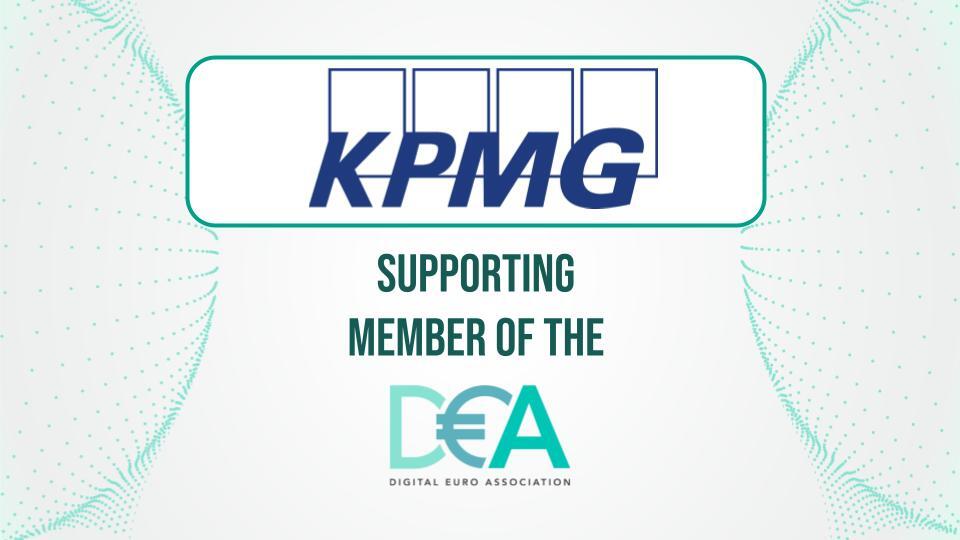All your Digital Euro resources in one place

International Organizations & Market Infrastructure
Publications

The Role of Stablecoins in Financial Sovereignty

Digital Euro Association Joins Forces with KPMG

Making Sense of Digital Money: Europe's Strategic Response to the Global Digital Currency Revolution
General Digital Euro Related Questions
The digital euro can take on different shapes which are issued by different institutions. It can be publicly or privately issued. While a digital euro issued by a (non-bank) e-money institute (e.g., STASIS, Circle) is an example for a privately issued digital euro, there is only one possible publicly issued form of digital euro: The European Central Bank is the sole potential issuer of a euro central bank digital currency (CBDC) which is the European solution in investigation for a to offer a digital alternative of cash to the Euro area (see ECB). In today’s digital age, around 1 trillion euros have been shifting towards cryptocurrencies and stablecoins, causing parallel circulations of money to emerge next to the ones monitored by monetary authorities of a country. Thus, there is not one single digital euro but rather several ones and digital euro is used as a blanket term.
Euros displayed on one’s bank account are digital but not digitised. The words “digitalization" and "digitization", although often used interchangeably, mean very different things. Digitalization can be defined as "the use of digital technologies to change a business model or process". Digitization, on the other hand, is the process of converting information itself from a physical to a digital format. In the context of transferring money, we saw a dramatic digitalization of the clearing, settlement and reconciliation processes over the past few decades. Money can therefore be considered to be already "digitalized". What is missing, however, is a digitized euro that does not only exist in siloed databases that have to be reconciled, but which exists in a digital form and can be transferred from peer to peer, similar to transactions in physical cash (token or bearer instrument).
Since current investigations are analysing the need for and potential design considerations of CBDC, there is no fixed date for the release of the digital euro. Initially, the first publications on a digital euro date back to November 2019, when an internal task force was set to explore CBDCs. After consultations, a resolution passed to kickstart the digital euro project. Shortly after, the investigation phase began and a market advisory group (MAG) launched. The development phase is expected to start in October 2023. Experts anticipate the introduction of the digital euro to be sometime around 2026.
Regardless of the issuing institution, transfers of digital money require an electronic register to prevent it from being copied and used multiple times. Therefore, digital euro transfers of all kinds must be documented. Since privacy is a fundamental human right (see article 8 of EU Charter of Fundamental Rights) in Europe, in the case of a euro CBDC introduction, the protection of personal data would be taken into account or adjusted accordingly in the design of the digital euro. Besides respecting the individual’s right to privacy and determining how their data is used, a digital euro’s potential design must also prevent the unlawful use of money (e.g., money laundering and the financing of terrorism). Private forms of the digital euro have to comply with data protection and digital asset regulation of the respective jurisdiction in which the issuing entity is registered, including meeting money laundering prevention requirements. One such example is the compliance with laws indirectly requiring certain levels of transaction transparency to be given such as the Crypto Travel Rule.
No. At the moment, the ECB emphasises that a digital euro would be complementing cash, not replacing it. Accordingly, cash will continue to be available in the euro area, where a digital euro would function alongside cash as a response to consumers’ evolving demand to pay digitally, in a fast and secure way.
Ideally, it would be possible to use the euro CBDC in all manner of payment scenarios, such as at the Point-of-Sale or at the online checkout, and also offline in combination with payment cards. This would mean that people who are less acquainted with digital technology would also have access to it. And a digital euro would ideally also boast other functions such as programmable payments. The experience of paying with a euro CBDC is not expected to differ greatly from digital means of payment that are common nowadays (e.g., PayPal, Stripe, Swish).
Digital Euro and Blockchain Related Questions
The ECB is exploring various approaches and technologies to make a digital euro available. This includes both conventional centralised and decentralised solutions such as distributed ledger technology (DLT). However, no decision has yet been taken.
Generally, a cryptocurrency is cryptographically secured digitised monetary value operated by a decentralised network. While a private digital euro might very well be a cryptocurrency (see stablecoins by Circle or Celo), a euro CBDC will be centrally managed by the ECB, possibly with support by commercial banks in the eurozone. Even if the euro CBDC by the ECB would be blockchain based, a permissioned network of validators is a common set-up that can be observed in other jurisdictions (e.g., China) which hampers the decentralisation aspect of cryptocurrencies.
While a basic range of programmable payment functions already exist in today’s banking system, smart contracts based on distributed ledger technology (DLT) offer further capabilities. The programmable euro describes a form of the euro that allows programmable payments. It includes DLT-based forms of the euro, e.g., a euro stablecoin, tokenized commercial bank money, tokenized e-money, or a DLT-based CBDC. Smart contracts inherit the capabilities to program any instruction, to impose tokens with properties and to generate tokenized assets. Instead, a programmable euro can be used to implement a token that carries an inherent logic. For instance, one could program this token in a way that it gains or loses value over time (e.g., to implement interest payments). Alternatively, one could ensure that this token can only be spent on certain things, such as food.
The main advantage of a programmable euro is that payment flows can be made "programmable". This programmability promises high automation potential for all types of payments. In addition, payments in the programmable euro can be processed more quickly, as the use of DLT implies that a majority of intermediaries are no longer required and delivery versus payments can be processed on one platform. The decentralised storage of transaction data also makes the system more resilient, making a system failure less likely. Primary benefits of such a form of the euro are related to increased automation, machine-to- machine payments, higher transaction speed, and lower counterparty risk.
Since central banks have a mandate to maintain the value of money, independently of its physical or digital form, a euro CBDC would be backed by a central bank, and thereby designed to be risk-free. The stability and reliability of stablecoins ultimately depends on the entity that issues them and on the credibility and enforceability of their pledge to maintain value over time. Private issuers may also use personal data for commercial purposes. There is no identifiable entity liable for crypto-assets, which means that claims cannot be enforced. Contrary to this, the ECB is authorised to print money and in times of recession and economic downturn acts as the lender of last resort.
The DEA Glossary
From stablecoins to CBDCs – this glossary holds 50+ of the most important terms related to digital money and assets that you often find in research, articles, books and other resources.
Account-based CBDC
CBDCs are held by the public in individual bank accounts where identities are tied to accounts. Account-based bank deposits or wallets are linked to a proof of identity that must be presented when transacting and setting up an account. Account-based and token-based CBDCs are not mutually exclusive categories.
Anti-Money Laundering (AML) regulation
Regulations to monitor and uncover illegally obtained funds and detect suspicious transactions or activities.
Application Programming Interface (API)
A connection between computers or between computer programs. It is a type of software interface, offering a service to other pieces of software. A document or standard that describes how to build such a connection or interface is called an API specification. A computer system that meets this standard is said to implement or expose an API. The term API may refer either to the specification or to the implementation.
Bank for International Settlements (BIS)
An international financial institution owned by central banks that "fosters international monetary and financial cooperation and serves as a bank for central banks" (source).
Bearer instrument
An instrument that entitles rights of ownership of the underlying security to the holder of the instrument. No ownership information is recorded, and the security is issued in physical form to the purchaser. The holder of a bearer instrument is presumed to be the owner.
Blockchain
An immutable, distributed cryptographic database of chronologically-ordered, timestamped blocks of transactions maintained by a network of computers, each of which stores a copy of the most up-to-date version.
Central bank
A public institution that is legally responsible for monetary policy, oversees the commercial banking system and manages the monetary supply of a country or currency union.
Central Bank Digital Currency (CBDC)
A form of money that complements cash and existing deposits in central bank accounts which is issued by a central bank and represents a direct claim against it. Unlike existing central bank deposits, depending on how it is designed, a central bank digital currency could involve new functionalities for existing counterparties.
Central bank money
A liability of a central bank, including banknotes in circulation and banks’ deposits with the central bank (i.e., central bank reserves).
Centralized ledger system
A ledger (i.e., record of financial transactions) kept in one place. Often as part of a closed system, i.e., with limited and controlled access, to help safeguard the ledger from unauthorized access. RTGS systems are, typically, centralized.
Combating the Financing of Terrorism (CFT) regulation
Combating the Financing of Terrorism (CFT) includes government laws, regulations, and other means intended to limit access to funding and financial services to restrict the movements of funds to terrorist organizations.
Crypto exchange
A centralized digital market-place where crypto currencies are traded (i.e., bought and sold) by individual or institutional traders or investors.
Crypto-asset
Digital representation of value (underpinned by cryptography) that can be digitally traded, transferred or used for payment. It does not include the digital representation of fiat currencies.
Currency
The official means of payment of a state/monetary union recognized as such by ‘monetary’ laws. More broadly a currency may also be a medium of exchange for goods and services that is generally accepted at its face value as a method of payment.
Cyber-crime
Crime committed to stealing or defrauding people by means of computer or internet.
Delivery
The transfer of financial instruments or commodities by means of book-entry or physical exchange.
Delivery versus payment (DvP)
A securities settlement mechanism which links a securities transfer and a funds transfer in such a way as to ensure that delivery occurs if – and only if – the corresponding payment occurs.
Digital asset
Any type of content that exists in binary data which is self-contained, uniquely identifiable, and has a value and usage rights.
Digital Euro
A digital form of the euro, either in the form of a CBDC or a stablecoin. A retail CBDC could be used by the general public in much the same way as cash, only in digital form. A wholesale CBDC on the other hand is accessible to banks and financial institutions. A digital euro CBDC issued by the ECB would be the central bank’s liability. Digital euro is unlikely to become the official name of the potential euro CBDC. In case a private entity issues a digital version of the euro (i.e., a stablecoin), it will be a termed private digital euro being the liability of the private issuer.
Digital wallet
A place where you can store electronic funds in token form, make transactions, and track payment histories on devices like phones and tablets. A digital wallet can be in the form of a mobile app or a card.
Digital Yuan/Digital Renminbi
The Chinese digital currency (also called digital RMB or e-CNY) by the People’s Bank of China. China is the first major world economy to officially release a digital currency.The e-CNY has legal tender status.
Double spending
A potential risk in a digital cash scheme in which the same single digital token can be spent more than once through information asynchrony on one or more ledgers. Unlike physical cash, a digital token consists of a digital file that cannot be duplicated or falsified.
Fiat currency
A currency established as money, often by government regulation, without an intrinsic value or backing, unlike a precious metal or a merchandise. It was a development step from the use of commodity money and was widely introduced in 1971.
Fungible
Fungibility allows a good or asset to be interchanged with other individual goods or assets of the same type. Fungible assets simplify the exchange and trade processes, as fungibility implies equal value between the assets (for example, commodities, dollar bills etc.)
Interoperability
The ability of different information systems, devices, and applications to access, exchange, integrate and cooperatively use data in a coordinated manner, within and across organizational, regional and national boundaries. In terms of digital money, interoperability may allow multiple technology protocols to communicate and interact with each other, thus reducing technical fragmentation and increasing efficiency when transferring value.
Know Your Customer (KYC) regulation
Client information that the local regulator lawfully requires payment service providers (PSPs) to collect about any potential new customer in order to discourage financial products being used for money laundering or other crimes.
Legal tender
Money that is legally valid for the payment of debts and must be accepted for that purpose when offered in the respective jurisdiction. Each jurisdiction determines what legal tender is but essentially it can be anything which when offered (“tendered”) in payment of a debt extinguishes the debt. There is no obligation on the creditor to accept the tendered payment, but the act of tendering the payment in legal tender discharges the debt.
Lender of last resort
Central banks usually fulfill the function of 'lender of last resort'. To ensure financial stability, the central bank provides emergency credit to financial institutions that are struggling financially and near collapse, for instance, if they no longer have other available means of borrowing, and their failure to obtain credit would dramatically affect the economy. This is necessary, for example, when account holders withdraw funds in a volume and time span that makes it impossible for the bank to liquidate assets quickly enough to meet the resulting demand, which is referred to as a "run on the bank."
Near-field communication (NFC)
A method of wireless data transfer between two electronic devices over a distance of 4cm or less.
Network effect
A phenomenon whereby the utility or value of a product or service gains additional value as more people use it. For example, the use of telephones - as the number of telephones which are connected to the network grows, the number of potential calls grows which leads to higher utility.
Non-fungibility
The inability of a good or asset to be interchanged with another unit of the token without any difference in its value and function due to its uniqueness. Non-fungible assets are one-of-a-kind (for example, unique arts like Monalisa painting, non-fungible tokens etc.). If token history can be tracked, a token might not be entirely fungible even though the function might be the same (e.g., when the token is blacklisted).
Non-fungible Token (NFT)
Non-fungible Tokens are used for asset tokens that represent ownership of unique items which cannot be interchanged since they have unique properties. In this sense, they are different from money or Bitcoin. Most commonly, the ERC721 Ethereum token standard is used to deploy NFTs.
P2P (Peer-to-peer)
Using, or being a network in which computers operated by individuals can share information and resources (e.g., money) directly without relying on a central server as an intermediary.
Payment instruments
Documents that can be used legally to effect payment in commercial banks in book money or currency. For example, cheques, bills of exchange, and promissory notes.
Permissioned blockchain
A blockchain where permission is required to access the ledger and/or participate in the validation of transactions using the relevant consensus protocol.
Permissionless blockchain
A blockchain where permission is not required to access the ledger or participate in the validation of transactions using the relevant consensus protocol.
Point-of-Sale (PoS) terminal
A device allowing the use of payment cards at a physical (not virtual) point of sale. The payment information is captured either manually on paper vouchers or by electronic means.
Programmable money
Tokenized money which is programmable such that it follows an inherent logic and can only be spent on certain goods or services when the programmed conditions are met (e.g., money tokens which are programmed to be redeemed by person X to buy food Y from restaurant Z).
Programmable payments
Payments that are automatically executed when certain conditions are met. Thus, these payments are automated and follow an inherent, predetermined logic based on algorithms. Programmable payments already exist in today’s banking system, for example, in the form of standing orders and direct debits.
Proof-of-concept project
A project used to demonstrate the feasibility or a principle of a concept or theory to determine if it has practical potential.
Public-private partnership (PPP)
Public sector includes government-controlled or government-like entities whose main objective is welfare maximization as opposed to the private sector whose main objective is profit maximization. PPP refers to a cooperative arrangement between two or more public (i.e., government) and private sectors. For example, a close collaboration between the central bank (public sector) and the commercial banks (private sector) to implement effective monetary policy and contribute to the stability of the financial system of a country.
Real Time Gross Settlement (RTGS)
A funds transfer system that allows you to instantaneously transfer money and/or securities. Debits are not netted with credits but rather settled on an individual order basis across the books of a central bank. RTGS payments are final once settled. RTGS systems are usually managed and run by central banks.
Real Time Payment (RTP)
Payments that share characteristics such as real-time or close to real-time initiation, clearing, and settlement. RTP rail is the digital infrastructure which facilitates real-time or close to real-time payments.
Remittance payment
Money that is sent from one party to another typically over long-distances or in the form of cross-border transactions.
Retail CBDC
A CBDC made available to and for use by the citizens of a country, merchants and institutions.
Seigniorage
Derived from the French expression “seigniorage”, referring to the profits made by the right to mint money. In connection with banknotes, seigniorage refers to the profit made by the central bank when issuing new money. It is the difference between the face value of newly issued money and the cost of producing, distributing and replacing them.
Settlement
Settlement of securities is the process whereby securities or interests in securities are delivered, usually against (in simultaneous exchange for) payment of money, to fulfill contractual obligations, such as those arising under securities trades. Nowadays, settlement typically takes place in a central securities depository.
Synthetic CBDC (sCBDC)
CBDCs that are issued by private organizations and are liabilities of these private organizations but are 100% backed by central bank reserves. They are thus not usually regarded as actual CBDCs.
Token
Representations of assets that allow information and value to be transferred, stored, and verified in an efficient and secure manner. These tokens can take many forms and can be programmed with unique characteristics that expand their use cases.
Token-based CBDC
Unlike the account-based CBDC, where proof of identity of the account holder must be presented for transacting, token-based CBDC involves verifying the validity of the token that can be used to perform transactions.
Two-tiered CBDC
A two-tiered structure involves enabling CBDC infrastructure through commercial banks which act as intermediaries by connecting the central bank with the public for the purpose of retail CBDC transactions. The collaboration between the central bank and the commercial bank forms the essence of a two-tiered structure: The CBDC is first distributed from the central bank to commercial banks which then distribute them to individuals, similar to the way cash is distributed today. At each stage the CBDC is still a liability of the central bank. The core ledger is held by the central bank, but the private sector acts as intermediary delivering accounts and services to the public.
Unbanked
People who do not have a bank account nor access to mainstream financial services.
Underbanked
Individuals who have a bank account but often rely on alternative financial services such as money orders, check-cashing services, and payday loans rather than on traditional loans and credit cards to manage their finances and fund purchases.
Wholesale CBDC
A CBDC issued and used for interbank settlements. It is not available to the public, but only to banks and financial institutions which are part of the central bank settlement system.
The DEA glossary and FAQ section has been made possible by the work of the DEA associates Atakan Kavuklu and Jaskaran Singh.


.png?width=512&height=512&name=bank%20(1).png)
